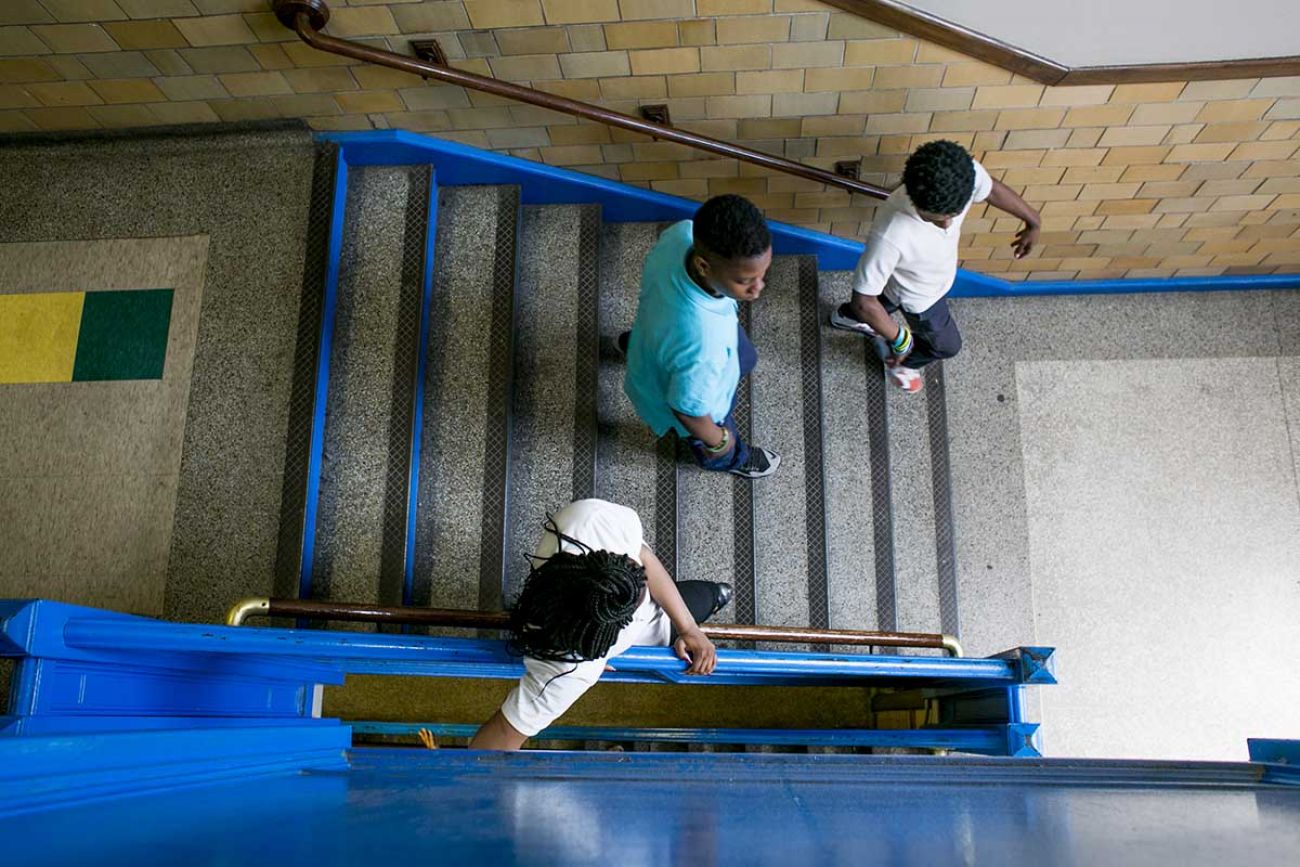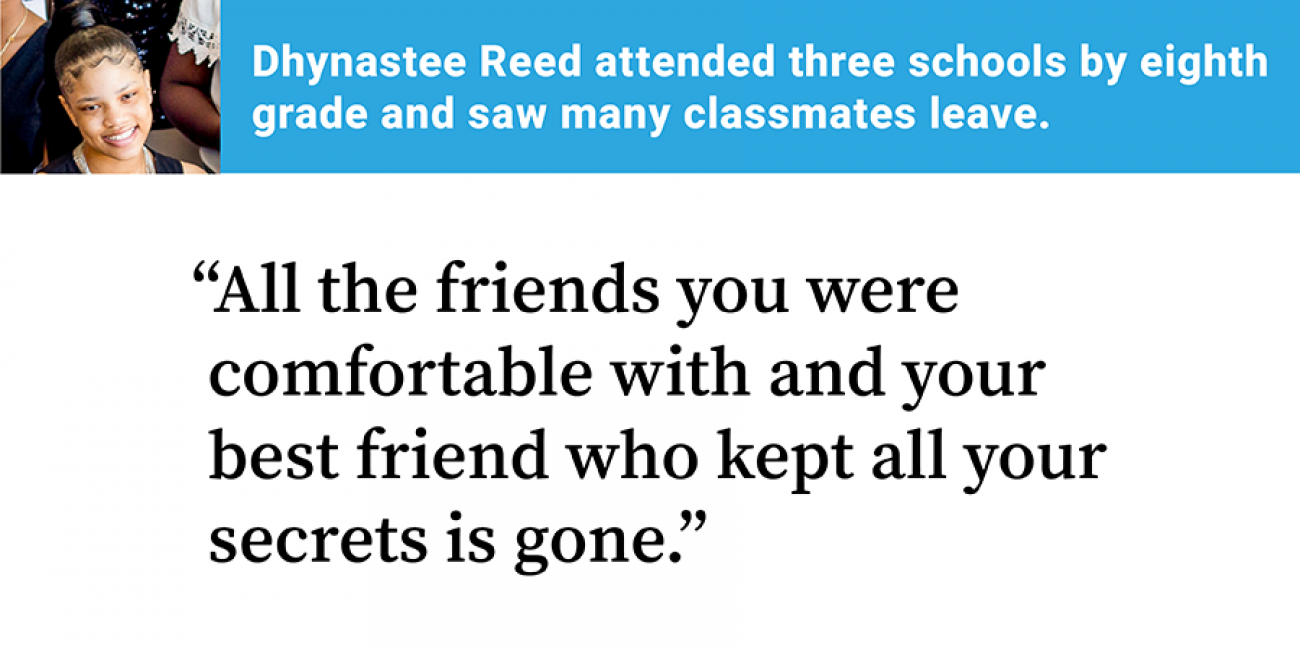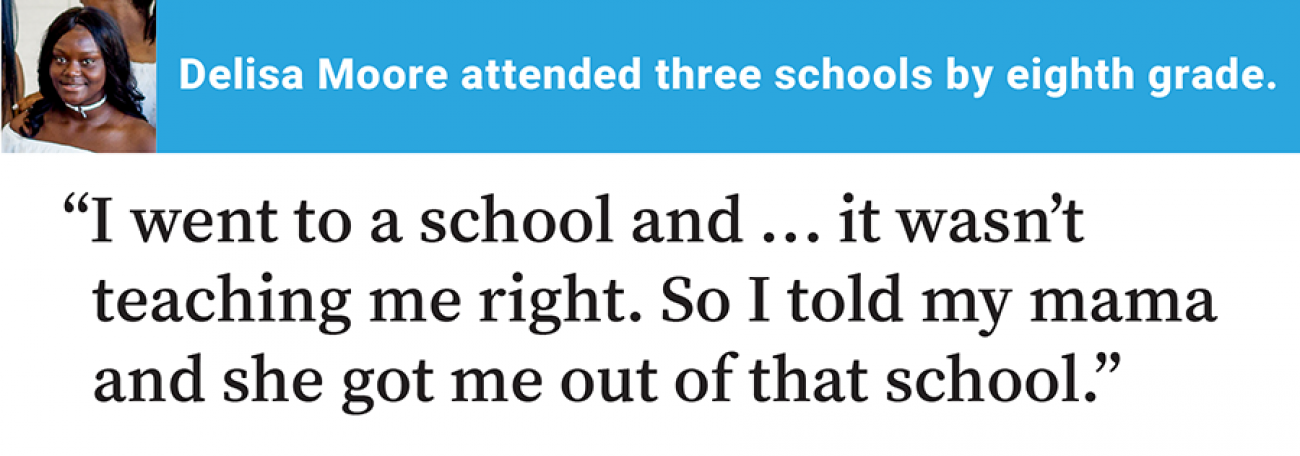Five ways to reduce harm of students frequently changing schools

Solving the damaging problem of Detroit students moving frequently between schools would require sweeping policy changes to both stabilize housing and improve the quality of public education.
But schools and policymakers could also take simpler, smaller steps to help ease a crisis created in which more than 1 in 3 elementary school students change schools every year.
Related:
- The children of 8B: Choice, school hopping brings ‘chaos’ to Detroit classrooms
- In Detroit, students never say goodbye. That’s a heartbreak for teachers.
- Detroit makes it easy to switch schools. So parents do. Frequently.
- When students leave Detroit schools, staff often has no clue where they go.
- Slideshow | A closer look at the students at Bethune School in Detroit
Here are five of them:
1. Ease access to student records
Centralized student records databases do not prevent students from frequently changing schools, but they do allow schools to more quickly assess and acclimate their new students.
The Michigan Department of Education is developing a new data system called the Michigan Data Hub that will allow districts to see the test scores their new students posted on state exams. The idea is one day to have a system that gives schools real-time access to new students’ test scores, transcripts, and discipline records from schools they previously attended.
Currently, districts can choose to use a state-run portal called MiLearn that allows schools to see MSTEP and other state assessment data for all students currently enrolled. Fewer than 100 school districts are participating in MiLearn out of more than 500 districts and 300 charter schools.
Typically, teachers and schools ask a student’s parents the name of their former school and then call that school to request records. Those records, when they arrive, don’t always include state test scores or special education plans.
If a child’s former school has closed, records are sometimes lost or hard to track down. This is an acute problem in Detroit, where about 200 traditional public, charter, and private schools have closed since 2005.
“Sharing of records solves admission issues and ensures that you have a really good idea of a child’s prior performance,” said Richard Welsh, a professor and researcher in the College of Education at the University of Georgia who has studied the problem of students frequently changing schools.
Michigan’s new records system could be operational in two to three years, said Tom Johnson, data manager with Michigan Data Hub and Kalamazoo County’s education service agency.

2. Adopt a unified enrollment system
Unified enrollment systems, also known as common enrollment systems, typically involve a computerized application that allows a family to apply to a number of charter and district schools by using only one form.
A number of cities have unified enrollment systems, including Denver, New Orleans, Washington D.C., Newark, Camden, N.J., and Indianapolis. The systems aim to help make enrollment simpler for families, especially students from low-income families who want to attend a school outside their neighborhood, and provide greater transparency in how seats are assigned. Some districts use them to create shared transfer policies and monitor trends in enrollment.
Supporters of common enrollment say that kind of information leads to increased competition and transparency that prompts schools to improve quality — which ultimately reduces the number and frequency of students changing schools.
The most robust systems ensure that when a student enrolls in a new school, officials can easily access information such as test scores and grades through a central database, said Maria Montoya, who was a co-founder of the unified enrollment system in New Orleans, called OneApp.
“Unified enrollment systems help cities and communities establish transfer policies and make sure kids don’t get lost in the system,” Montoya said.
Montoya, who is now manager of school and community partnerships at the Grand Valley State University Charter Schools Office, was part of the advocacy organization that piloted a common enrollment system for Detroit in 2016. It would have given parents a single application to use for every school in the city.
But the $700,000 system was controversial in a city where schools compete aggressively for students. Few charters participated due to fears the system was rigged to promote the district. The district, then run by a state-appointed manager, tabled the issue until a new school board could be elected. The board has been in office since January 2017 and has shown no interest in a common enrollment system.

3. Expand transportation
Currently, older students can use the city’s public buses, but for the younger students too small to ride the public bus alone, busing options are few. District students who take school buses must live near their assigned school.
That means students who change addresses often must change schools, too.
“If we really want to cut down on mobility, it has to be attacked through the choice process or transportation process,” Welsh said.
Detroit schools Superintendent Nikolai Vitti said it’s worth considering whether the district should provide busing to families who move so students can remain in their previous school.
“That may appear to be expensive,” he said. “But is it less expensive than losing that child?”
Every time a child transfers from one school to another, Vitti said, schools have to reshuffle class sizes and put time and money into helping new students adjust, testing them, gathering their records and making sure they know school rules and culture. And that disruption costs money, Vitti said. “We don’t quantify in dollars accurately enough the impact that this has.”
4. Standardize curriculum
Michigan has statewide academic standards that dictate what each student should learn every year. But state officials have no way of knowing how many districts and charter schools use curriculums that comply with those standards.
That means if a child moves from one school to another during a school year, the child invariably encounters vastly different lessons, textbooks, and expectations.
“The more standardized the curriculum is across the state, the better position you’ll be in to have school districts teaching similar type of things,” said Randy Liepa, superintendent of the education service agency for Wayne County.
But a standard curriculum, even across schools in the same district, can be a tough sell for teachers, who often say they want — and need — to have control over what and how they teach students.
“It’s a challenge for local school districts,” Liepa said. “They’re often not able to reap the benefits of a curriculum that builds off of each other’s [lessons]. It’s a significant challenge.”
5. Hire more and better trained staff
Kaira Gandy, a teacher who saw a dozen students join and leave her eighth-grade English class at Bethune Elementary-Middle School last school year, said students who move from school to school often require more individual attention.
“With transience, you need more hands on deck,” she said.
Detroit is ramping up its recruiting in response to a teacher shortage and large class sizes. Last year, the district fanned out across the country to historically black colleges and universities to try to fill its 200 teacher vacancies.
Hiring additional teachers would reduce class sizes and help all children, not just students who frequently change schools. To create a stable school culture, the district would likely need to hire more social workers and psychologists, too — and invest in training teachers to deal with the trauma or special needs of highly mobile kids, Gandy said.
This could both help schools cope with students coming and going and potentially reduce the problem. If students are more successful, parents will be more likely to keep them where they are.
About this project
This story is part of a series, “Moving Costs: How students changing schools hurt Detroit classrooms,” a joint project by Bridge Magazine and Chalkbeat. Erin Einhorn is Detroit bureau chief of Chalkbeat, a national education news site. Chastity Pratt Dawsey is a Bridge reporter.
See what new members are saying about why they donated to Bridge Michigan:
- “In order for this information to be accurate and unbiased it must be underwritten by its readers, not by special interests.” - Larry S.
- “Not many other media sources report on the topics Bridge does.” - Susan B.
- “Your journalism is outstanding and rare these days.” - Mark S.
If you want to ensure the future of nonpartisan, nonprofit Michigan journalism, please become a member today. You, too, will be asked why you donated and maybe we'll feature your quote next time!

